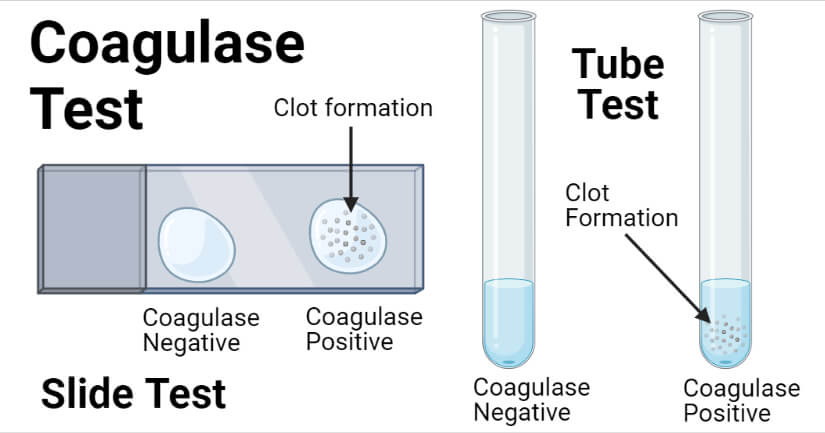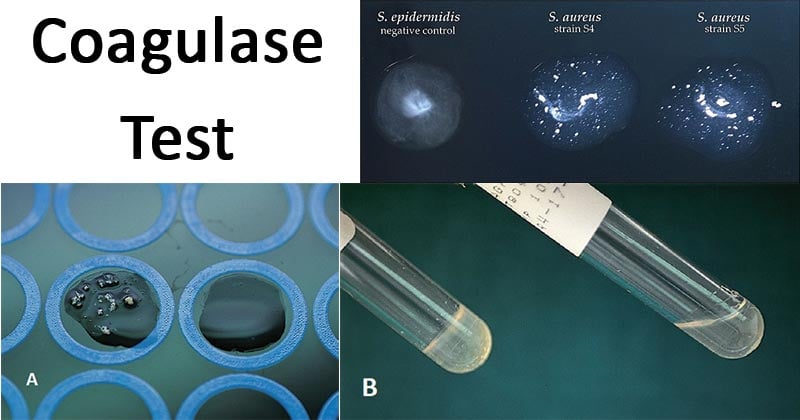A coagulase test is a biochemical test that is used to differentiate Staphylococcus aureus from other Staphylococci species like S. epidermidis and S. saprophyticus on the basis of the ability to produce the coagulase enzyme.
- The coagulase test is an important test that differentiates the species of the genus Staphylococci into two groups; Coagulase positive Staphylococci and Coagulase Negative Staphylococci.
- The coagulase enzyme acts as a virulence factor in some organisms as it interacts with the fibrinogen present on the host’s cell surface.
- Organisms with coagulase usually have a protective barrier around themselves, increasing their pathogenicity and resistance against the immune system.
- Coagulase is of two types; free coagulase and bound coagulase, each of which is detected by different methods.
- The bound coagulase is called the clumping factor and is detected rapidly by a slide test. The free coagulase, in turn, is detected in the test tube as a result of the formation of a clot.

Objectives of Coagulase Test
- To detect free coagulase and bound coagulase produced by different organisms.
- To differentiate coagulase-positive Staphylococci from coagulase-negative Staphylococci.
- To identify and differentiate S. aureus from other Staphylococcal species.
Interesting Science Videos
Principle of Coagulase Test
Coagulase is an enzymatic protein that is a thermostable thrombin-like substance, which converts fibrinogen into fibrin resulting in clotting or clumping. In S. aureus, two different forms of coagulase are found; free coagulase and bound coagulase.
Bound coagulase
- The clumping factor, termed bound coagulase, can be detected rapidly in the slide test, but this test requires several colonies and lacks sensitivity.
- S. aureus produces another substance in its cell wall, protein A, which binds to the FC moiety of human immunoglobulin G (IgG) and thus acts as a coagulase-reacting factor.
- When latex or erythrocyte particles are coated with IgG and with human fibrinogen, a staphylococcus will agglutinate if either clumping factor or protein A is present in the bacterial cell wall.
- The presence of the clumping factor is demonstrated by the ability of the organism to act directly on the fibrinogen in the plasma to clump it in a slide assay.
- The test for the clumping factor is rapid but requires several colonies, and also the factor might not be present in all S. aureus organisms.
Free coagulase
- Another type of coagulase that is released by the organism is free coagulase.
- Free coagulase is different from bound coagulase in that the clotting mechanism of free coagulase requires the activation of a plasma coagulase-reacting factor (CRF), which is a modified or derived thrombin molecule, to form a coagulase-CRF complex.
- The plasma added to the tube is preferably rabbit plasma which acts as a binding factor.
- The complex then reacts with fibrinogen to form the fibrin clot in a test tube.
Microorganisms Tested
- Colonies of Gram-positive cocci in clusters that are catalase-positive, as part of the identification of S. aureus.
- Positive blood cultures containing Gram-positive cocci in clusters for rapid detection of S. aureus.
Reagents and Supplies Used
Reagent
- Frozen plasma (preferably rabbit plasma) with EDTA. Human plasma is commonly not used for the test, as it is less sensitive and potentially infectious with human pathogenic viruses.
- 5% CaCl2 (optional)
Supplies
- Loops or sterile sticks
- Glass or plastic tubes
- Glass slides
Procedure of Coagulase Test
Coagulase can be detected by two different methods; tube test and slide test.
Slide Test
- About 10 µl of deionized water or physiological saline is added to a slide.
- Several colonies from a fresh culture are collected with an inoculating loop and are emulsified into the water to obtain a smooth milk-colored suspension.
- A drop of a rabbit or human plasma is added to the slide, and the clumping is observed immediately, not to exceed 10 seconds.
Tube Test
- The plasma is diluted with physiological saline. (Add 0.2 ml plasma in 1.8 ml saline)
- 5 ml of the diluted plasma is then added to a test tube. About 5 drops of the test organism culture are added to the test tube.
- The test tube is mixed and incubated at 37°C for an hour.
- The tube is finally observed for clot formation. If no clotting is observed, the tube should be examined at 30 minutes intervals of up to 6 hours.
Result Interpretation of Coagulase Test

Figure: Coagulase Test. Lower A- Slide coagulase test for clumping factor. The left side is positive; the right side is negative. Lower B- Tube coagulase test for free coagulase. The tube on the left is positive, exhibiting a clot. The tube on the right is negative. Above: Negative coagulase test in Staphylococcus epidermidis (left) and positive coagulase tests in Staphylococcus aureus (center and right). Lower Image Source A and B: Bailey and Scott’s Diagnostic Microbiology. Elsevier and Above Image Source: New HanseN (Wikipedia).
Slide Test
- A positive test is the demonstration of the agglutination of the bacterial cells after the plasma is added.
- A negative test is demonstrated by the lack of agglutination.
Test Tube
A positive test meets one of the following criteria:
- Complete clot formation or any degree of clot formation before 24 hours.
- No clot formation after the addition of 1 or 2 drops of 5% CaCl2 to a tube without a clot at 24 hours.
A negative test meets one of the following criteria:
- A lack of clot formation at 24 h at 25°C.
- No clot after 24 hours at 35°C, but after the addition of 1 or 2 drops of 5% CaCl2 to the tube, a clot forms.
Coagulase Positive organisms: Staphylococcus aureus and other animal host bacteria like S. pseudintermedius, S. intermedius, S. schleiferi, S. delphini, S. hyicus, S. lutrae, S. hyicus
Coagulase Negative organisms: Staphylococcus epidermidis, S. saprophyticus, S. warneri, S. hominis, S. caprae, etc.
Uses of Coagulase Test
- The coagulase test is used to determine the production of coagulase by different microorganisms.
- This test can also be used to differentiate S. aureus from other Staphylococcal species.
- Staphylococcal species are differentiated into coagulase-negative and coagulase-positive species on the basis of the production of the coagulase enzyme.
Limitations of Coagulase Test
- Methicillin-resistant S. aureus can be deficient in bound coagulase, which results in a negative slide test.
- S. intermedius and S. hyicus may be positive in the tube test; these species are generally found only in dogs and pigs, respectively, but are as infectious as S. aureus when they infect humans.
- S. lugdunensis and S. schleiferi produce slide coagulase, but the reaction is more efficient if the human plasma is used rather than rabbit plasma.
- Citrated blood should not be used as false-positive results can occur.
- Coagulase testing cannot be performed from growth on mannitol salt agar.
References and Sources
- Biochemical Tests for the Identification of Aerobic Bacteria. (2016). Clinical Microbiology Procedures Handbook, 3.17.1.1–3.17.48.3.DOI:10.1128/9781555818814.ch3.17.1
- Berke, A., and R. C. Tilton. 1986. Evaluation of rapid coagulase methods for the identification of Staphylococcus aureus. J Clin. Microbiol. 23 :916–919.
- 3% – http://universe84a.com/coagulase-test/
- 1% – https://www.scribd.com/presentation/225246434/Serology
- 1% – https://www.researchgate.net/publication/288058469_Coagulase_Gene_Typing_with_Emphasis_on_Methicillin-Resistance_Staphylococci_Emergence_to_Public_Health
- 1% – https://www.ncbi.nlm.nih.gov/pubmed/28109774
- 1% – https://healthjunta.com/gram-positive-cocci-inclusters/
- 1% – https://assets.thermofisher.com/TFS-Assets/LSG/manuals/IFU1580.pdf
- 1% – http://www.uwyo.edu/molb2210_lab/info/biochemical_tests.htm
- 1% – http://vlab.amrita.edu/?sub=3&brch=73&sim=703&cnt=1
- <1% – https://www.microrao.com/micronotes/coagulase.pdf
- <1% – https://www.instructables.com/id/How-to-make-plasma/
- <1% – https://vlab.amrita.edu/?sub=3&brch=73&sim=703&cnt=2
- <1% – https://quizlet.com/40246991/bio-326m-test3-flash-cards/
- <1% – https://quizlet.com/246767065/5-27-coagulase-test-flash-cards/
- <1% – https://microbeonline.com/diagnostic-tests-biochemical-tests-coagulase-test/
- <1% – http://www.uvm.edu/~btessman/calc/calc1a.html
